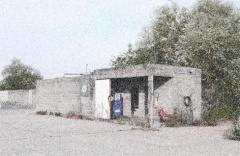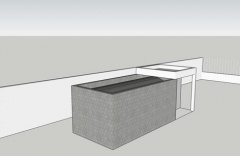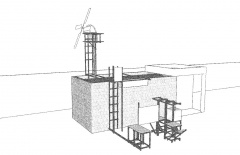Version
About "Version: prototypical lab" project, proposal, ideas and documentation.
Contents
To Dominique
"
From: lahaag <in#######ag.org>
Subject: Re: research paper
Date: 26 Aug 2011 14:17:58 GMT+02:00
To: dom <domle#######ree.fr>
Hey Dom,
...
I'm still working on new windmills and devices, dealing with the same concepts as the old ATKN1 project: energy, art, communication, poetics, … Part of this development is happening now for OKNO and the TIK2 project. Together with others, I'm developing wind clocks, which are to be put anywhere around the world and get connected to generate a new standard of time, the TIK time, wind time. Anyways that's the concept. It's very much related to what I was doing with the ATKN project. That's probably also the reason why they asked me to participate.
One of the issues, that arose again during the TIK project, is how to present this research or development to the public. A lot of it is tinkering and playing around. Ideas get put down on wiki's, are explored in small models during workshops. There's lots of ideas formulated and concepts made. All very experimental. A lot of threads come out of this research, but not all, lead to something. But that doesn't make them less interesting, tough. They are part of the process. But how to make this process interesting for the public. The public being this collective of people who look at your work with different interests : people expecting to see a work of art, participants in a workshop, other artists looking for information, people interested in the technical aspects, …
On the other side there is the artist, me. I want to share my work with my public, and am concerned how to do this. My work being in progress, under development, in the state it currently is. Normally as an artists you don't show all the intermittent stages of the development of your artwork. You show the end result. But what if this processes is what you are really interested in?
At the same time I was thinking about my own position as an artist, what to do with my organization, my space and so on. As I'm no longer involved in a collective, being no longer part of OKNO, and not setting up code31 meetings, much resolves about my individual art practice. How to get people involved, to participate, to relate my work to, get the necessary feedback, for inspiration and energy, … I mean, I have always functioned within collectives, and collaboration is essential in my work. How to open it up again?
...
“
Taken from a project proposal written to Dominique Leroy, following my residence at Ecos in march 2011.
Version
Version builds upon Openstructures, a project which explores the possibilities of a modular construction model based upon a geometric grid. This model provides a shared framework for tinkering, prototyping and experimenting. It's a collaborative model where everyone contributes with parts, components and structures.
At the same time it can literally be the platform or the space, modular and open, within which all this experimenting can take place.
Version is a reflection on a working method. A process based upon a consensus on a formal approach of "how to make things" in which sharing and experimenting are key elements. The focus is on the creative process rather then on what comes out of it.
Version starts with the development of "Version:base". A small mobile lab, built according to the principles of the openstructures model. It is a simple empty shape which holds space for two persons. This is the starting point. It will get shaped, altered or expanded. New components will be added. Parts will be removed. It will get transported and installed at different locations. Parts will get abandoned. All according to the development of projects within the version context.
Version refers to 'version control' , a system which is used to document changes, programs or other information stored in computer files to manage. Usually such a system used in the development of software, so more people can make changes on the same files. It is a system that processes documents and records. It gives an overview
Version:base
Scenario for Ecos
Thinking about all this, I thought, why not really make a kabinet, after all I am involved in TIK, the time inventors kabinet.
And what's a kabinet other then a lab or a workspace. My workspace would become a kabinet.
That was the starting point.
Then I thought to make it mobile, meaning I should be able to displace this lab or Kabinet. It should not be inside my workspace.
Especially not as I'm working with wind. I had to take my lab outside. Makes sense, duh.
I had to make it open. Open in the sense of an open lab. Open for people to enter and participate.
A kabinet is also a piece of furniture, a shelve, a display.
A bit later I came across http://openstructures.net. A project which explores the possibility of a modular construction model where everyone designs for everyone on the basis of one shared geometrical grid. It initiates a kind of collaborative Meccano to which everybody can contribute parts, components and structures.
In there I found the structure, the form which my cabinet should take. Or the way I should proceed in building my Kabinet. I can built my projects using this modular construction model and at the same time built structures within which to show my work. In this sense the work would be the workspace. The workspace would reflect the method. Within this structures I can built my experiments, explore my ideas. The structure can expand and grow according to development. At the same I can invite others to participate to work within the structure. It's open
versatile modifiable adjustable expandable light mobile, others can built upon, …
The idea is that I start working on the site in Reze, where you were building the buckminster fuller dome. I need some elevation to catch the wind, so I thought to start building upon the concrete building, or upon the wall surrounding the site. (I'm still thinking to built a windmill, a different type, one that compresses air to produce sound.) At the same time smaller structures could be exported into the city, to other interesting locations. These smaller structures could contain small experiments, tryouts, to gather data and experiment with, …. Parts of the structure, that i use to built the windmill, could be expanded or used for other purposes. For instance a piece could contain a small glasshouse, or an extension could be made to fit a barrel to gather rainwater. Whatever, … I think there are lots of possibilities, which fit the other concepts you are working on with ecos, for instance we could design small structures, which could be attached to balconies to grow plants.
A quick sketch to pictures this : Straight from the design table as all this is really fresh.
"Version:base"
documentation


